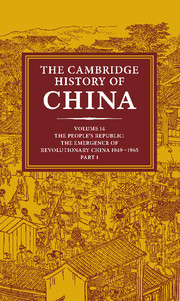Book contents
- Frontmatter
- 1 The reunification of China
- PART 1 EMULATING THE SOVIET MODEL, 1949–1957
- PART II THE SEARCH FOR A CHINESE ROAD, 1958–1965
- 7 The Great Leap Forward and the split in the Yenan leadership
- 8 The Chinese economy under stress, 1958—1965
- 9 New directions in education
- 10 The Party and the intellectuals: phase two
- 11 The Sino-Soviet split
- Epilogue
- Bibliographical Essays
- Bibliographical essays for chapters
- Bibliography
- Appendixes: Meetings and Leaders
- Conversion Tables: pinyin and Wade-Giles
- Glossary Index
- Map 1. China’s physical features
- Map 2. PRC: political (Wade–Giles romanization)
- Map 3. PRC: political (pinyin romanization)
Epilogue
from 11 - The Sino-Soviet split
Published online by Cambridge University Press: 28 March 2008
- Frontmatter
- 1 The reunification of China
- PART 1 EMULATING THE SOVIET MODEL, 1949–1957
- PART II THE SEARCH FOR A CHINESE ROAD, 1958–1965
- 7 The Great Leap Forward and the split in the Yenan leadership
- 8 The Chinese economy under stress, 1958—1965
- 9 New directions in education
- 10 The Party and the intellectuals: phase two
- 11 The Sino-Soviet split
- Epilogue
- Bibliographical Essays
- Bibliographical essays for chapters
- Bibliography
- Appendixes: Meetings and Leaders
- Conversion Tables: pinyin and Wade-Giles
- Glossary Index
- Map 1. China’s physical features
- Map 2. PRC: political (Wade–Giles romanization)
- Map 3. PRC: political (pinyin romanization)
Summary
By the mid-1960s, the record of the Chinese Communist regime was a mixture of triumph and tragedy. Its early years had witnessed a startlingly successful nation-building effort. The authority of the new government had been quickly established, assisted by universal relief at the restoration of peace and unity. The economy was rehabilitated and inflation brought under control. Land reform and a succession of campaigns in the cities exhibited the regime's willingness to use various forms of coercion, including execution, to eliminate opponents and intimidate potential critics. The Party state swiftly came to dominate all sections of society.
Despite the immensity of these tasks, the Chinese leaders had felt confident enough to take on the United States in the Korean War. In the event, the war effort assisted the consolidation of the regime and cemented relations between the Chinese and their hitherto somewhat wary Soviet allies. By the time an armistice was signed in 1953, China's leaders were initiating their 1st Five-Year Plan, on the Soviet model and with Soviet assistance. In 1955–56, at Mao's command, the Chinese Communist Party (CCP) demonstrated its organizational virtuosity by collectivizing China's 500 million peasants within months (a process that had taken the Russians years and cost countless lives).
This victory of the socialist revolution (quickly reinforced by similar achievements in industry and handicrafts) permitted domestic relaxation as the regime switched focus from ideological to economic goals and sought to mobilize the broadest possible coalition in the interest of development. But when Mao, reacting to Soviet de-Stalinization and the Hungarian revolt, attempted to moderate further the Party's methods of rule with the Hundred Flowers and Rectification campaigns, the experiment exploded in his face.
- Type
- Chapter
- Information
- The Cambridge History of China , pp. 539 - 542Publisher: Cambridge University PressPrint publication year: 1987



